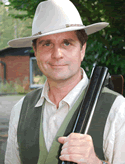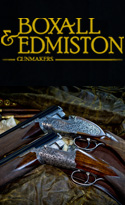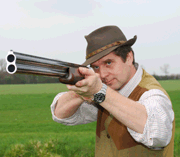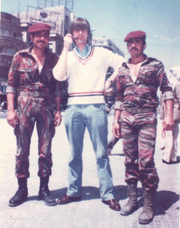Hunting Kudu in Africa
For the British stalker, Africa offers a fascinating change of environment and a special challenge. But, the essential skills required to hunt African plains game are familiar – recce, get the wind right, and good marksmanship (never take a shot of which you can’t be sure). As far as quarry is concerned the variety and abundance is truly staggering. Southern Africa offers amongst many others species: springbok, impala, blessbok, bontebok, bushbuck, jackal, warthog, bushpig, waterbuck, duika, nyala, hartebeest, steenbuck, sable, roan, mountain reedbuck, eland, oryx, oribi, fallow deer (and a variety of other immigrants including wild boar and mouflon). One might go on to list a host of dangerous game species, and, others, which, arguably, are best sought on a game viewing safari.
There is one game species, however, which, along with the little, but potentially fierce, bushbuck, and the magnificent long horned oryx – known locally as gemsbok – that stands apart in my book – Tragelaphus strepsiceros strepsiseros, better known as the Greater Kudu. Kudu are famed for their spiralled horns and their white stripes. Older kudu bulls are especially interesting to the hunter. The ‘grey ghost’ is not only stunningly beautiful, but elusive too. He has fantastic sight and hearing as well as a great sense of smell (though curiosity may sometimes be his downfall). One must pit all one’s hunting wits against him, though, and, Diana and St.Hubert must be on side too. You need some luck when hunting kudu bulls!
Two varieties of Kudu are commonly hunted in Eastern Southern Africa – Greater Kuduas mentioned, and, a subspecies, the Eastern Cape Kudu which is a little smaller but still spectacularly beautiful (there are other sub species, but there is some argument about their classification). My friend the hunter and zoologist Stuart Anderson Wheeler notes that one may also hunt, at a substantial price, two rarer types of Greater Kudu: Tragelaphus strepsiceros (in North East Africa), and, Tragelaphus strepsiceros(Chad and Western Sudan). Lesser Kudu (Tragelaphus imberbis) are sometimes hunted as well. They are differently proportioned to the Greater Kudu, and, though comparatively common, populate a much smaller range. They are seen, for example, in Ethiopia, Kenya and Tanzania
The Greater Kudu as encountered in southern Africa is magnificent and still offers sporting value ($1,000 US being a typical price for a ‘good representative specimen’ bull). Males may weigh between 400 and 600 pounds plus. They are big creatures. Mature bulls usually have horn tips that point upwards, younger ones, tips that go back (females are hornless and typically weigh 250-450 pounds). Bulls also have an impressive beard, sometimes called a mane. They achieve their first full horn curl by about 24 months. Typically, they will go on to have two and half twists or even three. Record beasts may have horns that measure over 70.” Anything over 60” is spectacular, even 50” may be considered good. I have yet to measure any of the dozen or so Kudu that I have shot – hunting with a tape measure is not my thing and, naively perhaps, I do not encourage it. But, trophy quality does interest me and the individual variations one sees in horn mass and curl is fascinating.
One intriguing fact about male kudu that if you look down through either of their spiral horns, you will be able to see the beast’s eye. This is because Kudu use their horns to forage (for example, bringing down leaves from branches - they also like to eat shoots, and, fruit if available). As bulls age, they may begin to lose bodyweight. An ethical hunter may therefore look for a beast which has visible signs of aging – such as a lightening of his coat and ribs protruding – it is a bonus if he has great horns too).
Where should one go to hunt? The places that offer Kudu at sensible cost are South Africa, Zimbabwe (known for some great specimens), and Namibia. I have shot kudu in both South Africa and Namibia to date, and, have seen them in Botswana and Tanzania. They range fairly wide as a species though. You will also find them in Kenya, Eritrea, Zambia and Angola amongst other countries, and, they have even been introduced into the USA (in New Mexico, I believe).
My long-time hunting chum, Paul Roberts, a much experienced Africa-hand notes that hunting Kudu is very similar to hunting roe buck in the UK. I would agree, but add that hunting a good Kudu bull also has a certain magic for me because the beast itself is so regal and secretive. It is a privilege just to see one. Sometimes, you realise, as your eyes adjust, that there is a beast only a short distance away looking through the leaves. They certainly tend to be woodland creatures, though older males may bask in open fields during the middle of the day (where I have shot two recently). Another curious fact is that you may hear them bark (usually when asserting themselves), or, bleep, if in distress.
The typical Kudu stalk is through cover, though, and, unless you are very fortunate, you will have several fleeting encounters, before getting anywhere near the possibility of a shot. My experience of Kudu is that there is more of luck involved than with some other creatures (which does not mean that basics are not just as important, on the contrary, you will need to be on top of your game). They are not only shy, but less predictable than some antelope. This, of course, adds to their charm. There is some of the magic of the woodcock and the chamois there. Most of mine have been shot in poor light. Their coat, of course, is designed as camouflage and is most effective.
In Southern Africa, the usual routine is driving round looking for spoor and then debussing and following tracks. With Kudu, though, this is often done as per the norm, I have found that stalks frequently start with a tracker seeing a beast in the far distance. One then manoeuvres in to get a shot in classic fashion. One may not succeed! Many times I have returned to the same ground later in the day, or the next day, after an unsuccessful stalk. You can also ‘bump’ kudu unexpectedly when walking in cover. Because, this is quite a high probability, I like to use heavier calibre rifles for hunting Kudu (see box) - you need a ‘brush busting’ bullet.
As for shot placement, I avoid heart shots on kudu – as I do for most African game – and go either straight up the leg (for a pinning shoulder shot), or, in ideal circumstances, for the neck. I always think the disadvantage of the heart shot in Africa – especially if one is slightly under-gunned – is the possibility of a long trek through the bush to find one’s quarry. Heart shots usually lead to a beast walking on 20-150 metres in my experience. That can complicate things greatly even with a first class tracker. Better to put it down on the spot, with a sensible choice of shot, and perfect bullet placement. It is also important to get familiar with using sticks or a tripod as these will often be offered by southern African professional hunters who must get fed up with some of their client’s poor marksmanship. I always use a dead rest or a tripod if I can. This is not always possible, but we should never forget our obligation to harvest game humanely.
My most memorable hunts have been in the highlands of the Karoo, and, in Nambia, where I encountered one beast about as far from the beaten track as one could ever get. Recently, I was very lucky to be able to shoot three superb Kudu bulls in as many days with Oribi Outfitters when we were hunting in the popular (from a shooting perspective) Limpopo region of South Africa. This was a cull hunt made more interesting because we were trying to capture it on camera (which presents all sorts of challenges with Kudu because they usually present such fleeting opportunity). Nevertheless, we did get lucky and readers may be interested to have a look at a clip from the film that was completed by searching Youtube ‘Mike Yardley hunting in Africa’.
Guns for Kudu
Any stalking rifle can be pressed into service to shoot Kudu. I have seen them taken well with .243s. .270 is popular in South Africa (as it is on the hill in Scotland), but my minimum for Kudu would be a 7mm (7x57, 7mm-08, or, 7mm Rem Mag), or, .30 calibres such as .308, 30-06 and our venerable old .303. The 300 H&H, 300 Win Mag, 300WSM or Remington Ultramag would all be ideal. My own gun is an old .300 Win Mag Tikka 65 with a stainless Border Barrel – a fantastic and practical all-round African rifle – with ammunition available just about everywhere (it’s not too powerful for the hill either). I would not rule out a .300 Weatherby Magnum for Kudu (a blown out 300 H&H), .338 (Win Mag or Lapua), .375 (H&H or Ruger) or, indeed, a .416 either (Rigby or Remington).
Bullet choice is all important. I had excellent results recently with Winchester Ballistic Silver Tip, though, one might safely advise any of the well proven hunting bullets such as Nosler Partition (‘just the right amount of penetration’ notes Paul Roberts), Trophy Bonded bearclaw,’ the RWS TIG, and, Norma Oryx. Though it may sound ‘techy, ’if you start hunting plains game seriously, take it from me, you will become interested in bullet performance.
As far as action types are concerned, bolt, straight-pull, or even break-action or falling block single-shot might all do the job. Most of my recent kudu and plains game hunting has been with a Border-Barrels modified .300 Win Mag Tikka as noted, but, I would love to shoot a kudu with an in-line muzzle-loader having just shot an impala with one (a Mkonto .50 calibre inline made in South Africa by Craig Clintworth – firing a light all copper 300 grain .458 bullet in a plastic sabot). Calibre and cartridge are more important than action type, but, whatever you choose, make sure you are confident with it and that it is accurate. I have shot Kudu from 30 to 250 yards.
Your telescopic sight will be particularly important because the chances are that you will be hunting in poor light – they are not called the grey ghost for nothing. I would advise a top quality scope with a large objective in a 7x50 or a mid range zoom such as a 2.5-10 or 3-12x 50 or 56. I used the new Swarovski Z4 2.5-10 x 56 with illuminated aiming point and it was outstanding – one of the best scopes that I have ever used.








